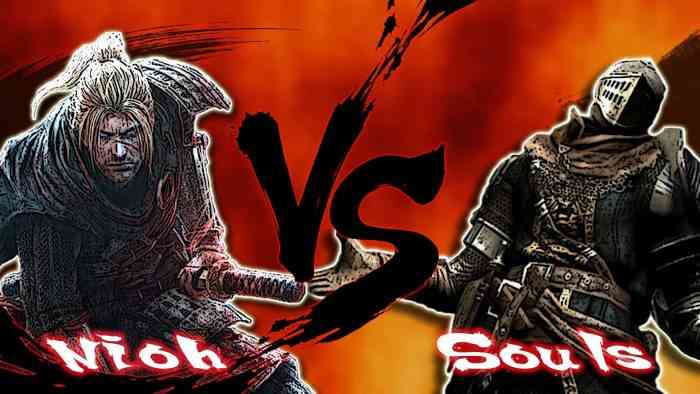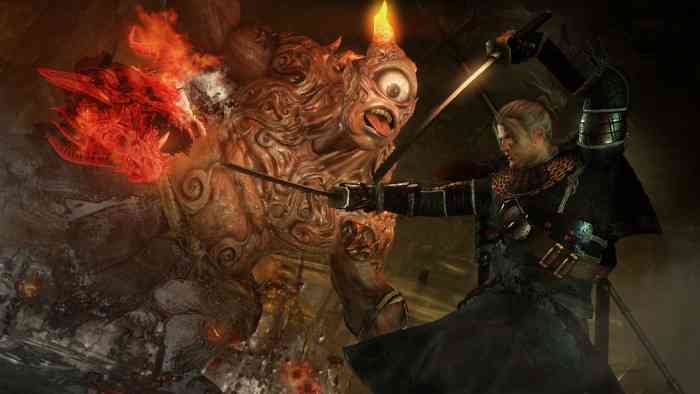Nioh vs. Dark Souls
With the Dark Souls series supposedly ended (for now) and a sequel to Bloodborne teased at PSX, 2017 was a quiet year for FromSoftware. However, that left the gates open for other “Soulsbornes” to take the spotlight, and the year saw a serious influx of takes on the formula. Of these, perhaps the most critically-acclaimed has been Nioh, which released on PS4 back in February, followed by a “complete edition” on PC last month.

Now, there’s no doubt that Nioh feels heavily inspired by From’s games, with strategic combat, daunting enemies, experience loss on death (unless it’s retrieved), and of course, a punishing level of difficulty. In fact, I’ve frequently described the game to those unfamiliar as, “Dark Souls in a feudal Japan setting”. However, make no mistake: Nioh is no Dark Souls clone. The aesthetic change is obvious, with Dark Souls’ oppressive, gothic trappings eschewed for a Japanese setting populated with all manner of Yokai and samurai. Really, though, it’s what goes on beneath the surface that makes Nioh not only unique but potentially more accessible than Dark Souls.
Story
Right off the bat, Nioh’s narrative takes center stage, with the player taking control of William in his fight against various supernatural forces. Story-focused cutscenes are plentiful without breaking up the action and lay out a clear progression path. Based in the Warring States Period, many famous names and faces show up, giving the proceedings a slightly more grounded feeling compared to Dark Souls’ fantastical plot.
This grounding is also aided by Nioh’s stellar voice acting and character interactions. Whereas in Dark Souls, you play a silent protagonist, William is fully-voiced. Of course, this makes it a bit more difficult to project oneself onto him (I don’t know about you, but I can’t really relate to a gruff, blonde, Irish dude), but it also allows him to develop as a character, along with everyone around him. People get fleshed out and involve you in the world, as compared to the NPCs in Dark Souls who mostly just talk at you. For instance, early in the game, William meets an actual antagonist and gets to team up with Hanzo Hattori to learn the ways of the ninja. While this certainly removes some of the mystique that Dark Souls does so well, it also gives a clear driving force for the game instead of “ring some bells and kill whatever’s in your way”.
__________________________
“…Nioh not only unique, but potentially more accessible than Dark Souls.”
This addition of clear motivation for the player turns out to be a huge asset. In Dark Souls, it can be extremely easy to grow discouraged after countless deaths, since the vague storyline deliberately obfuscates what your goals are. I get that this is the point of Dark Souls, but I think that Nioh’s approach can show easily-discouraged players a slightly better time. If you get invested in the plot, you want to see William succeed, and you want to know where he’ll have to go and what he’ll have to do next. In contrast, Dark Souls can sometimes feel like a slog between set pieces as you die over and over in your search for new things to be killed by.
Design
While the story also helps with Nioh’s sense of forward momentum, its mission-based structure is what really seals the deal. In contrast to Dark Souls’ massive, interconnected world, Nioh is divided up into smaller (yet still lengthy) missions that take place in contained maps. However, these maps aren’t insignificant by any stretch, featuring multiple pathways and shortcuts that can be opened to hasten progress on subsequent attempts. This helps to give them a feeling of openness while generally eliminating the need for backtracking. It also means that victory can often be just within sight; an early area saw me desperately fighting through a burning village just so I could get to a ship that I could see from the start. This, combined with the shorter missions, means that it can be far easier to feel like you’re making steady progress in Nioh; you don’t have to measure your success in the number of bosses you’ve killed.
Outside of missions, there are an assortment of training options, additional challenges, and more. A merchant allows you to buy and sell items, but also lets you reforge and level-up your equipment. You can even change the appearance of different articles, so dexterity-focused characters don’t have to fear if they prefer the designs of Nioh’s heavy armor. This all gives opportunities to take much-needed breathers from the intensity of some levels, though I can see where some may feel it breaks the game’s immersion.

Gameplay
Story and structure changes are all well and good, but what does Nioh bring to the gameplay table? Well, a whole lot, as it happens.
For starters, Nioh’s stamina system (referred to as “Ki”) works a bit differently from Dark Souls’; namely, you can instantly regenerate portions of it. After launching an assault, a properly-timed button press will restore a significant chunk of your expended Ki (known as a “Ki Pulse”). Additionally, if there are any Yokai smoke areas below you (zones that slow down your natural Ki recharge), they can be purified to remove them from the battlefield. This mechanic can fundamentally change the flow of combat, especially when you consider that moves like dodging will reset your recoverable Ki. As such, Nioh’s combat tends to focus more on actual attacking, whereas Dark Souls is often more evasion-centric. Of course, dodging is still critical in Nioh, but many fights (particularly against easily-staggered foes) can almost morph into a rhythm game, where you attack, Ki Pulse, and keep attacking until you’re on your last sliver of Ki or your foe is dead.
Speaking of combat, if you thought that keeping track of light and strong attacks, dodging, backstepping, consumable items, and so forth in Dark Souls was a handful, Nioh might be a bit overwhelming. In addition to all these, you can swap between low, medium, and high stances, each of which changes your attack patterns and has different side effects. High attacks tend to be powerful, but leave you more vulnerable, medium stance is a balance that’s good for defending, and low stance focuses on fast, light strikes and maneuverability. If you truly want to master Nioh’s combat system, you must learn how to effectively swap between these three stances on the fly. To say that there’s a learning curve is a bit of an understatement.
One thing that can make the combat a bit easier to handle is that Nioh isn’t quite as punishing when it comes to the accumulation of wealth. In Dark Souls, everything centers on the souls you collect from fallen enemies. You expend souls to level up your character, improve your gear, and buy new items. While this keeps things simple and adds a nice risk/reward system to your investments, it can also be overwhelming and add to the frustration of losing many souls to a couple unfortunate deaths. This is somewhat counteracted by Nioh’s system, in which money can be collected to purchase and upgrade items, materials can be used for crafting weapons and armor, and Amrita is used to level up. Of these, only Amrita is lost on death and has to be recollected. It means that, while you may find yourself missing out on some levels from time to time, you won’t be completely left in the dust. Plus, with the mission-based structure, there’s a decent chance that you’ll at least finish each level with a healthy pile of Amrita. I, for one, seriously appreciate it, as I’ve had several screaming fits after defeating a tough boss in Dark Souls and then immediately dying, losing all my hard-earned souls, and dying on my way to pick them up again.
__________________________
“…many fights (particularly against easily-staggered foes) can almost morph into a rhythm game”
Nioh also has a “living weapon” system, in which killing enemies not only provides you with Amrita, but also builds up a meter on your weapon. Once this meter fills, you can activate your living weapon, granting temporary invincibility and allowing you to unleash your “guardian spirit”: a being that you choose at the start of the game and can swap out depending on the situation. This means that, if you get stuck on a particular enemy, it’s possible to grind to fill your meter, then take on your foe with the power of your guardian on your side. It takes away some of the guesswork and tedium of grinding for an indeterminate number of souls in the hopes of eventually feeling more powerful than the enemies in the area.
Now, while that does seem a bit overpowered (invincibility? In a Soulsborne?), let me assure you that it’s anything but. In my experience, I found that it was quite effective for dispatching minibosses and the like, but main bosses generally kept a decent chunk of health. Plus, your time in this state gets reduced if you get hit, so it’s not as simple as activating your invincibility and whaling on your foes for a few seconds. Then again, that’s what I tended to do, so…it kind of works.

I saved the best for last, though, as Nioh has collectibles and ones that actually serve an in-game purpose! Scattered throughout each level are several spirits known as Kodama. These tiny green beings wear bowls on their heads, and finding them will send them back to the nearest shrine, which are Nioh’s equivalent of Dark Souls’ bonfires. Then, any time you’re at that shrine, you can choose a Kodama blessing to receive. The more Kodama of a particular type you find, the more powerful the blessing. These can range from increased chances to obtain certain items from enemies to increased Amrita gain from fights, and all can be useful for different styles of play.
Of course, I just wanted to talk about the Kodama because they’re absolutely adorable. Guiding one back to a shrine sees William leaning over, pointing in the general direction of the shrine, and being met by a jubilant hop and polite bow from the Kodama before it disappears. I’m not going to lie: my heart melts every time I see it!
Conclusion
I feel like I’ve only scratched the surface of what differentiates Nioh and Dark Souls, but this is an article, not a novel. Plus, half the fun is diving in for yourself and finding out what makes each feel distinct. In my experience, though, Nioh feels like the more accessible of the two titles, with many mechanics and structural decisions that seem designed to prevent players from feeling like they’ve been completely outpaced by the game. Regardless, at the end of the day, both games have their high points, and I certainly don’t want to suggest that one is better than the other. They’re similar enough that fans of one should try the other but different enough that you won’t be feeling deja vu for long.
…scratch that. Kodama are literally the best, most adorable things in the world. Nioh is god-tier. Dark Souls is trash. Case closed, end of story.